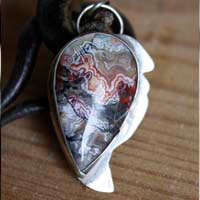- Jewelry
- Inspiration
- Good Deals
- Paintings
- About
- Contact
JEWELRY
- Anklet
- Bracelets
- Brooches
- Cufflinks
- Earrings
- Pendants & Necklaces
- Rings
- Draw your jewelry
- GOOD DEALS
- How to clean your jewel
- Metal we used
INSPIRATION

Mexican crazy lace agate: history, healing properties and lithotherapy

Mexican crazy lace agate properties

Mexican crazy lace agate, also known as Mexican agate, rodeo agate, or rosette stone depending on the mine of origin, is renowned for its vibrant colors intertwined in wavy patterns. This unique stone features hues ranging from opaque white to red, gray, and yellow.
This fascinating stone is primarily mined near Villa Ahumada in the state of Chihuahua, Mexico, from rock layers dating back to the Cretaceous period, approximately 90 to 65 million years ago. The formation of these agates results from successive deposits of silica in rock cavities under specific pressures and temperatures, creating the unique and complex patterns we observe today.
History, beliefs and legends about the Mexican crazy lace agate
Although Mexican crazy lace agate was documented as early as 1895, it wasn’t until the 1950s that it was rediscovered by American geologists involved in the construction of a highway.
Local Pre-Hispanic populations considered this stone sacred, using it in rituals and as offerings to appease the gods. The "crazy" and wavy patterns of crazy lace agate, often tinged with red, were perhaps seen as a representation of blood and the circulatory system, important symbols in Mesoamerican cultures where sacrifice (including self-sacrifice) was practiced to gain divine favor.
This agate, with its intricate network of lines, was likely perceived as a reflection of the complexity and vitality of life.
Mines: Mexico
Healing properties and benefits of the Mexican crazy lace agate
- Crazy Lace Agate is renowned for its efficacy against allergies, strengthening the immune system.
- It promotes the enhancement of the sense of smell, gallbladder, bladder, and kidneys.
- Athletes use it to prevent cramps.
- This agate helps dispel fears and feelings of insecurity.
- It improves blood circulation, especially in the legs and feet, by promoting the dilation of blood vessels, potentially preventing varicose veins.
- Let’s not forget to include the general properties of agate, acknowledged in lithotherapy for promoting emotional and physical balance, as well as its soothing effects.
 Please note that all healing properties presented for gemstones are gathered from various sources. This information is provided as a service and is not intended to treat medical conditions. It is recommended to consult a healthcare professional for serious medical issues and not to rely solely on gemstones as a treatment.
Please note that all healing properties presented for gemstones are gathered from various sources. This information is provided as a service and is not intended to treat medical conditions. It is recommended to consult a healthcare professional for serious medical issues and not to rely solely on gemstones as a treatment.
Mexican crazy lace agate jewelry samples
To learn more about litotherapy, we recommend you the following books:





